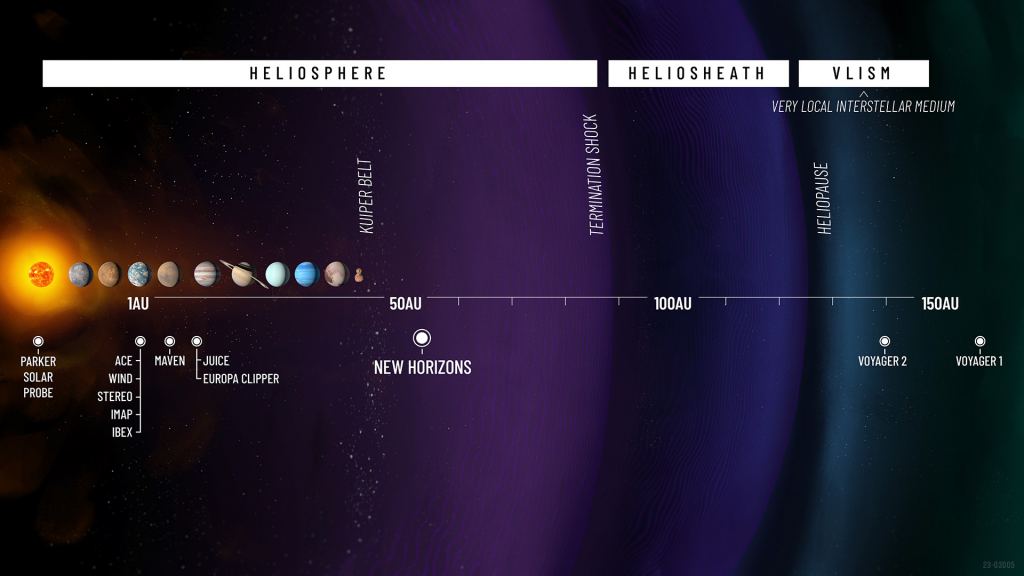New Horizons is Funded Through the Decade. Enough to Explore Another Kuiper Belt Object
By Carolyn Collins Petersen
The ongoing saga of the New Horizons mission—will it get truncated and its science team disbanded?—may have some resolution. Dr. Nicky Fox, associate administrator of NASA’s Science Mission Directorate at NASA Headquarters announced last Friday that mission operations will continue until at least the end of the decade.
“Following a senior review and feedback from a diverse set of stakeholders, NASA will continue the New Horizons mission focus on multidisciplinary science,” she announced in social media and a press release. “Its extended operations will continue until the spacecraft exits the Kuiper Belt, expected in 2028-2029.”
Fox did not provide further specifics. The announcement seems to still be stressing heliophysics while acknowledging planetary science in the Kuiper Belt under the “multidisciplinary” label. Presumably, the extension of mission operations also means the current science team remains in place. However, that wasn’t mentioned specifically.
New Horizons Pioneered Kuiper Belt Exploration
New Horizons launched in 2006 on a trajectory to fly past and study the Pluto system in 2015. It then flew past Kuiper Belt Object Arrokoth in 2019 before continuing out through the Kuiper Belt. Throughout its mission, the spacecraft has studied other Solar System bodies. It has done dust measurements, gathered information about other smaller KBOs, and gathered heliophysical data. And, team members are searching for another flyby target.

The Kuiper Belt has been a largely unexplored part of the Solar System. It holds a number of icy bodies and dwarf planets such as Pluto, Eris, Makemake, and others. It’s the source of so-called “short-period” comets, which have orbital periods less than 200 years long. Studying Kuiper Belt bodies in detail provides insight into a treasury of materials dating to the Solar System’s origin. Coupled with the great distances involved, the Kuiper Belt represents one of the last frontiers to explore.
NASA’s Proposed Changes for New Horizons
Mission scientists expected to continue the New Horizons explorations through the late 2020s. However, earlier this year, an unusual proposal floated out from NASA. It suggested that the mission’s focus shift entirely to heliophysics, omitting much (if not all) planetary science. In addition, the current mission team faced replacement by other unnamed scientists who would use the spacecraft. That engendered a huge outcry from the mission and members of the planetary science community.
A collective of 25 prominent planetary scientists, including Planetary Society board chair Jim Bell, Lori Garver (past Deputy Administrator of NASA), Jim Green (Past Director of NASA’s Planetary Science Division), Candice Hansen-Koharcheck (Past chair of the American Astronomical Society’s Division of Planetary Sciences and Past Chair of NASA’s Outer Planets Assessment Group), author Homer Hickham, Wesley T. Huntress (Past Director of NASA’s Solar System Exploration Group), astrophysicist Sir Brian May, Melissa McGrath (past NASA official and AAS Chair of DPS), and many others signed on to a letter of protest about the mission’s proposed truncation. In addition to articles here and elsewhere, the National Space Society began a petition aimed at getting national (and international) attention focused on the matter. Thousands of people weighed in to signal their support.
Saving New Horizons’s Important Science
All this activity on behalf of the mission definitely focused attention on NASA’s proposal. Implementing the proposal would have affected important science. According to Principal Investigator Alan Stern, New Horizons is the only one of its kind achieving Kuiper Belt science. Earlier this year he pointed out that it’s a perfectly working spacecraft. “We’re studying new, more distant KBOs from angles and closer ranges that you can’t get from Earth to determine their surface properties, their satellite counts, and shapes, things that cannot be done well except by a spacecraft in the Kuiper Belt. And of course, we’re on the prowl for a new flyby target if one can be found,” he said.
Stern calls the mission a “national treasure”. The spacecraft remains healthy and useful, and with the extension, it has the time to finish the job it was sent to do. “The New Horizons mission has a unique position in our Solar System to answer important questions about our heliosphere and provide extraordinary opportunities for multidisciplinary science for NASA and the scientific community,” said Fox. “The agency decided that it was best to extend operations for New Horizons until the spacecraft exits the Kuiper Belt, which is expected in 2028 through 2029.”
Funding and Management
NASA announced that funding for this “new extended mission” (which appears to be much like the proposed one it was already flying) comes from NASA’s Planetary Science Division. That division and Heliophysics will jointly manage the program. The agency will assess the budget impact of continuing the New Horizons mission. Funding within the New Frontiers program (including science research and data analysis) will be rebalanced to accommodate extended operations. Further, it seems that future projects may be impacted, but NASA provided no information about specifics.
The spacecraft is working well and has enough power and fuel to operate into the mid-2050s. It’s entirely possible that New Horizons could send back information when it passes through the boundary to interstellar space. That’s if it’s still “awake” and NASA has provided funds to enable future scientists to listen for the spacecraft’s last goodbye.
For More Information
NASA’s New Horizons to Continue Exploring Outer Solar System
NSS Pushes to Prevent Dramatic Downgrade of New Horizons Science Mission
The post New Horizons is Funded Through the Decade. Enough to Explore Another Kuiper Belt Object appeared first on Universe Today.

October 3, 2023 at 05:35AM
via Universe Today read more...

Post a Comment